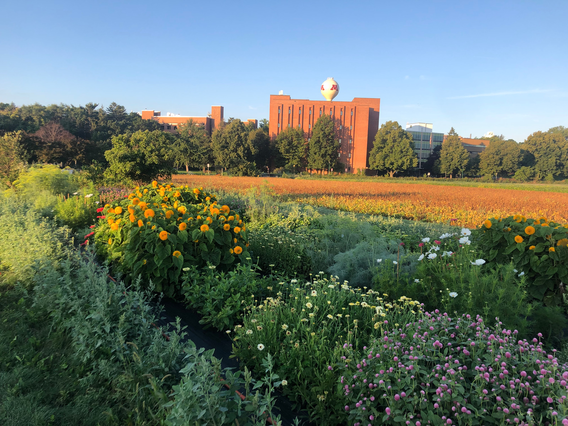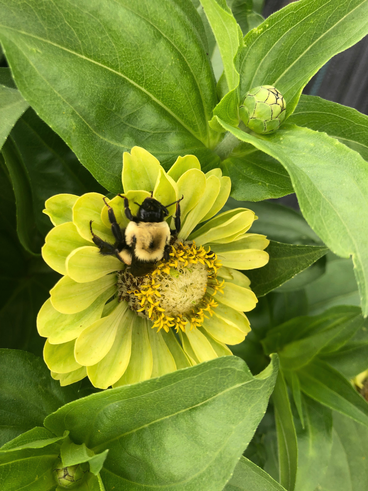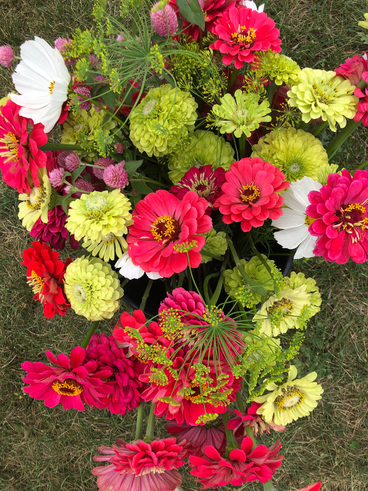By: Sarah Anderson
Fruit and vegetable crops often take center stage when it comes to Minnesota horticulture as they are critical to our local food system, but did you know that Minnesota is also home to more than 100 cut flower farms? Though often viewed as frivolous, locally grown flowers are in increasingly high demand across the U.S; yet, the U.S. is the #1 importer of cut flowers. Over 80% of cut-flowers sold in the U.S. are currently imported versus just 25% of fruit and vegetable crops, despite both having a similarly short shelf life. This means that bouquets often travel over 5,000 miles to reach U.S. markets. They’re transported via airplanes, trucks, and cargo shipments from top flower producing countries such as the Netherlands, Ecuador, and Columbia–generating a large carbon footprint. Imported flowers require large chemical and water inputs during production. There is a great opportunity to reduce the flower industry’s carbon footprint by increasing supply and access to locally grown flowers.

By growing 10 cut flower varieties suited for the Upper Midwest, this research evaluated the economic and environmental viability of local cut flower production in Central Minnesota. The project was funded by the Institute on the Environment and carried out by Dr. Brandon Miller, Assistant Professor in the Department of Horticulture, and Sarah Anderson, graduate student in the MPS Horticulture Program. Flower varieties were selected in collaboration with The UMN Bee Squad based on their perceived value to pollinators and trialed at the University of Minnesota's Learning Garden, located on the St. Paul campus.
Data on cut flower variety yield and market values for bouquets versus wholesale were collected and analyzed to determine the most profitable varieties. This assessment was completed with the support of Christine Hoffman, Founder and Director of the Twin Cities Flower Exchange. Pollinators were monitored throughout the growing season to better understand the nectar, pollen, and habitat resources provided with the support of Elaine Evans, UMN Bee Lab Educator and Researcher. The primary goal of this research was to increase awareness and knowledge of local flower production and its environmental benefits as a powerful approach to reducing the carbon emissions resulting from imported flowers. These metrics specifically target the IonE Impact Goals of 1) building a carbon-neutral Minnesota and 2) envisioning sustainable land use in Minnesota, as well as the UMN’s MNtersections initiative to build a fully sustainable future as a part of the MPact 2025 System Wide Strategic plan.

It has been widely observed that increased habitat biodiversity, the presence of flowering plants, and sustainable growing practices lead to increased pollinator abundance and diversity. The beauty of growing many cut flower varieties is that they are in bloom all summer long, especially when succession plantings and season extension methods are utilized. This creates a reliable source of pollen and nectar, in contrast to most fruit and vegetable varieties that flower for a much shorter period of time, if at all, before they’re harvested. This study found that Bumblebees (Bombus spp.) were the most prevalent pollinator group, making up 41.9% of all pollinators monitored. Honey Bees (Apis spp.) were the second most prevalent, comprising 24.2% of pollinators. This finding is important because a quarter of the Bumblebee population (an indicator pollinator group for all wild bees) is at risk of extinction in North America.

In addition to being a beneficial pollinator resource, carbon emissions resulting from transportation are significantly lower for locally grown flowers versus those air-freighted from other countries. Luckily, similar to the local food movement, consumers are becoming more informed and are beginning to consider “flower miles” when shopping. Just under 20 miles were spent commuting, harvesting, prepping bouquets, and delivering to a local bakery, Honey and Rye, for this study’s pop-up sale! Other environmental benefits of locally grown flowers include reduced water inputs due to more controlled irrigation techniques, reduced likelihood of chemical fungicide treatments on flowers not crossing borders due to import regulations, and reduced waste generated from packaging.
This research confirmed that cut flower farms do provide meaningful nectar, pollen, and habitat resources to a diverse group of Minnesota pollinators, and there is indeed a market opportunity that benefits consumers, growers, and our environment.
Sarah Anderson was the recipient of the Gordon and Margaret Bailey Horticulture Science Scholarship. If you would like to support students like Sarah, please donate today!
